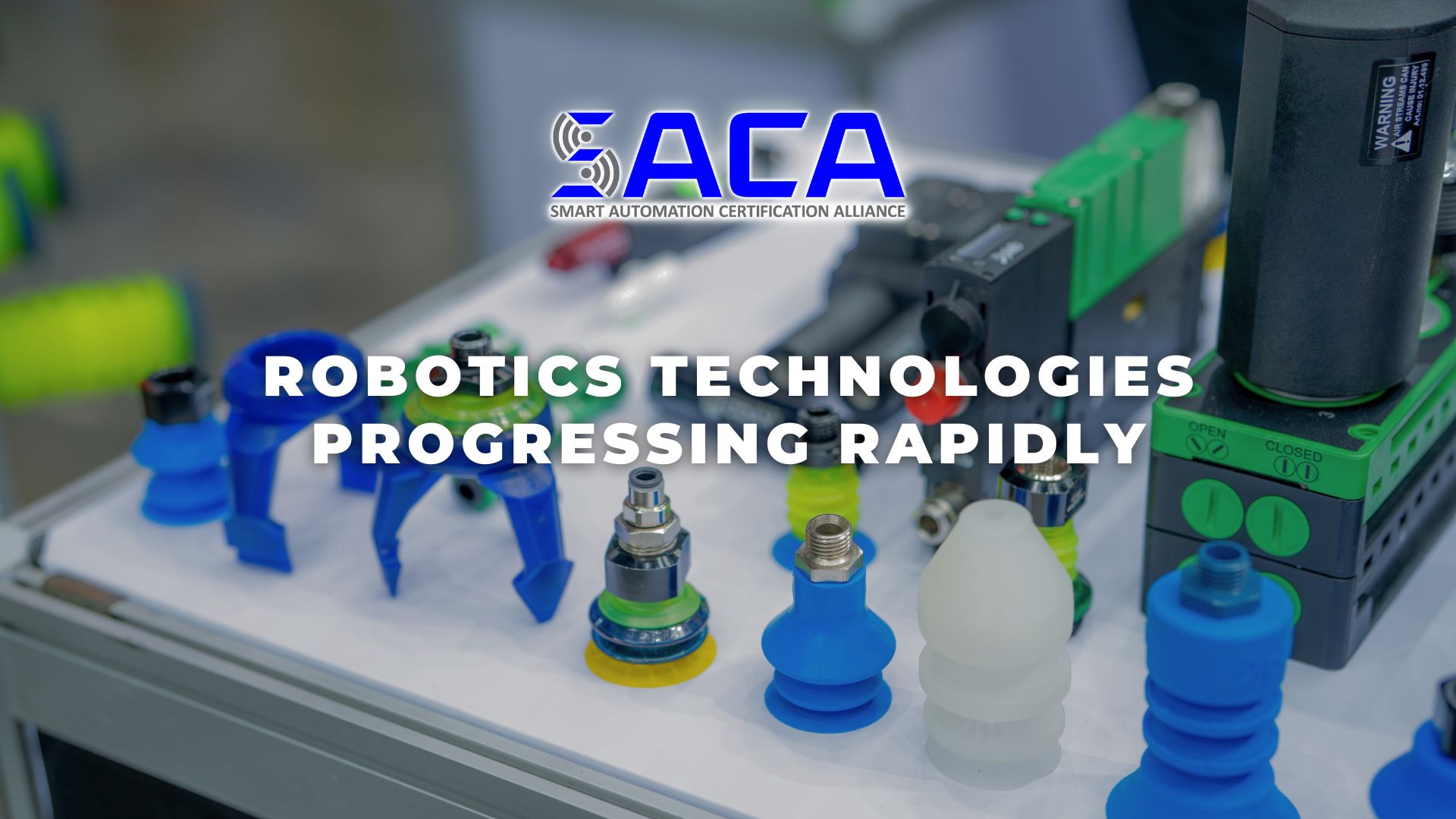Register for the Next SACA Gold Certification Workshop!
WHAT: SACA Gold Certification Workshop
WHEN: Monday, June 10 – Friday, June 14, 2024 | 8 am-4 pm
WHERE: Lakeshore Technical College, Cleveland Campus
SACA is excited to announce its next Gold Certification Workshop, offered in partnership with Lakeshore Technical College and LAB Midwest. This workshop presents an excellent opportunity for educators and workforce professionals interested in upskilling to gain valuable SACA credentials.
The workshop will feature assessments for 20 different Gold Level certifications, comprised of the Associate level certifications and many of the micro-credentials from the Certified Industry 4.0 Automation Systems Specialist certification. Participants will train on equipment before certifying in the specified testing areas.
IMPORTANT DETAILS:
CLICK HERE to register for the Gold Certification Workshop
For more information, download a Gold Certification Worshop flyer.
COST: $475 per day; includes lunch | $1,995 for the entire 40-hour week
Note: Silver certifications must be completed before taking gold exams. If you have not completed your silver certifications, please contact Lucas Dulmes at lucas.dulmes@gotoltc.edu.
When completing registration for this event please select the date/dates you would like to attend along with the SACA Gold Level certifications you would like to complete. Please select no more than 3 per day to allow enough time to complete each certification.
We look forward to seeing you in June at the Cleveland Campus of Lakeshore Technical College for the Gold Certification Workshop. To learn more about Lakeshore Technical College and how SACA certifications are helping students prove they possess the hands-on skills needed to excel in the modern workplace, check out this video:
- Published in News
Robots Continue to Drive Adoption of Advanced Automation Technologies
Are you old enough to remember when robots were futuristic, rather than an ever-expanding part of our everyday lives? While most of us still don’t have Jetsons-level robots to take care of all our housework, many of us do own robotic vacuums that at least clean the floors on a regular basis.
Many of us also work alongside robots in the workplace. This is especially true if you’re in any kind of modern manufacturing. From welding robots to automated guided vehicles, robots have become deeply ingrained in today’s manufacturing facilities that are embracing all sorts of new advanced automation technologies.
In a recent Forbes article, author Steve Banker recounts his experiences attending MODEX trade shows in 2016 vs. 2024. In 2016, he only remembered three robotics exhibitors at the show. This year, however, “33 exhibitors had the word ‘robot’ or ‘robotics’ in their title. And almost all the large material handling vendors and systems integrators that don’t have the term ‘robotics’ in their name, were also displaying bots.”
That’s why his visit to MODEX 2024 led Banker to declare this “the year of the robot.” What caught Banker’s eye this year were the “robots that have ‘hands’ for picking cases or eaches.” According to Banker, “[e]ach picking involves picking individual units and putting those items in a container. Until recently, each and case picking were just too difficult for bots.”
The robotics on display at MODEX 2024 revealed solutions that have made each and case picking possible by combining five different technologies:
- Robotic arms: “This is a mature technology that has been used for years in automotive manufacturing.”
- Robotic “hands” powered by suction cups: “The solutions have compressors that provide the right amount of suction for picking different sizes and weights. There can be different arrays of suction cups.”
- Vision systems: “Vision systems combined with AI allow the system to know what suction cups to initiate and how much compression to use.”
- Artificial intelligence: “Machine learning also comes into play. For example, if the system has trouble picking a particular item, an alert can tell a planner not to allow that stock keeping unit to enter the robotic picking queue.”
- Software: “Finally, complex software can be necessary. If you are floor loading a truck with containers of different sizes and weights, the software knows that the weight must be evenly distributed, that easily crushed items need to go on top, and there is a Tetris type solve to make sure as many items as possible can be loaded. Pallet loading requires a similar type of software solve.”
While Banker notes that many of these solutions “picked slower than a human would and could not cover the same range of SKUs that a person could,” he notes that they’re the future because “people burn out on this kind of task after a couple of hours and need to be rotated to a different task. A bot just keeps working. It is also increasingly tough to hire warehouse workers. Finally, a bot can work in an environment, hot and cramped, that a worker would not.”
Should this concern humans who fear being replaced by robots? Absolutely not! Companies that have embraced new automation technologies report that employee fears of job loss are overstated, because these advanced automation technologies will not and cannot replace highly-skilled human workers. Simply put, there has to be someone to operate, maintain, repair, and troubleshoot these technologies throughout the facilities they’re used in.
Whether you decide to train a current worker or hire someone with the special skills you need, you’ll need to be sure they have the skills to hit the ground running. If they possess a certification from the Smart Automation Certification Alliance (SACA), you can feel confident they’ve already proven they have the knowledge and hands-on skills needed for working with advanced smart automation technologies. For example, companies looking to implement the latest robotics technologies would be interested in workers with SACA’s Certified Industry 4.0 Robotics Specialist certification. Be sure to check out SACA and all it has to offer!
- Published in News
Skill Development Essential to the Future of Manufacturing
It’s no secret that United States manufacturers still struggle with an ongoing labor shortage. Those unfamiliar with the manufacturing “skills gap” might assume that it’s a result of the upheaval that occurred during the COVID-19 pandemic. However, the problem existed long before 2020.
For many years, manufacturers have encountered difficulty filling open positions, particularly for jobs that require highly technical skills. The industry-wide embrace of advanced automation technologies, often referred to as “Industry 4.0,” has created a growing demand for highly skilled workers, but the supply of such workers has yet to catch up.
In fact, a 2021 study by Deloitte and the Manufacturing Institute projected that more than two million manufacturing jobs could go unfilled by the end of this decade. As post-pandemic recovery continues, manufacturers must find a way to close the skills gap as soon as possible.
According to a recent IndustryWeek article by Josh Cramer, “career possibilities in the fields of additive manufacturing, robotics, automation and AI” will “require candidates who are properly trained in critical thinking, problem-solving, communication and innovation.”
Cramer notes that “[t]o generate a manufacturing resurgence in the U.S., we must tackle this workforce need with a multifaceted approach that includes building awareness—among both youth and adults—of pathways to entering the industry.”
Moreover, he believes that “[o]n the technical side, it is imperative that the candidates are equipped with enhanced skills, particularly for the benefit of small- and mid-sized companies that make up the majority of manufacturing in our nation (and must do more with less).”
While the manufacturing skills gap is a national problem, Cramer advocates for local solutions. For example, he believes “[t]here is great strength in leveraging national resources on the local level to create manufacturing skills programs. Bringing in local leaders in industry, government and academic to define skill sets, competencies and career pathways will both strengthen the local economy and help further a national manufacturing resurgence.”
In the author’s opinion, “[t]he future of US manufacturing involves innovation, education, and collaboration to empower the next generation and strengthen the nation’s manufacturing sector.” He envisions “local teams leverag[ing] the nation’s best practices and strategies, including outreach, onboarding programs and training for reskilling and upskilling.”
The collaboration needed will involve educators following the lead of industry partners to ensure that they’re teaching the advanced skills that industry needs most. Educators would also do well to prepare their students for career pathways that are defined by industry-standard certifications that represent a set of skills defined by industry as necessary to thrive in the modern workplace. For example, if workers possess a certification from the Smart Automation Certification Alliance (SACA), employers can feel confident they’ve already proven they have the knowledge and hands-on skills needed for working with advanced smart automation technologies. SACA has been hard at work collaborating with industry leaders to develop a wide variety of industry-standard certifications that will help employers find workers who possess the advanced connected-systems skills they need to take their businesses to the next level. Be sure to check out SACA and all it has to offer!
- Published in News





